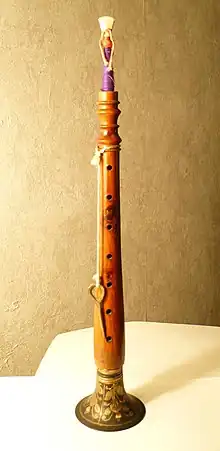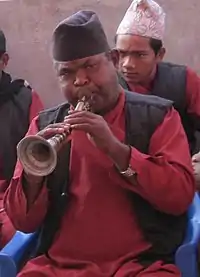 | |
| Other names | Babol basi, Saanai, Sahnai, Sanai, Serunai, Shahnai, Shanai, Shenai, Shenoy, Sahnai |
|---|---|
| Classification | |
| Related instruments | |
The shehnai is a musical instrument, originating from the Indian subcontinent. It is made of wood, with a double reed at one end and a metal or wooden flared bell at the other end.[1][2][3] Its sound is thought to create and maintain a sense of auspiciousness and sanctity and as a result, is one of the nine instruments found in the royal court. The shehnai is similar to South India's nadaswaram.
Characteristics
This tubular instrument gradually broadens towards the lower end. It usually has between six and nine holes. It employs one set of quadruple reeds, making it a quadruple reed woodwind. To master the instrument, the musician must employ various and intricate embouchure and fingering techniques.[1]
The shehnai has a range of two octaves, from the A below middle C to the A one line above the treble clef (A3 to A5 in scientific pitch notation).
A shehnai is often but not always made with a body of wood or bamboo and a flared metal end.[4]
Origin of the shehnai
The shehnai is thought to have been developed by improving upon the pungi (a woodwind folk instrument used primarily for snake charming).
The counterparts to the shehnai played in Western India and Coastal Karnataka are indigenous to the territory. Shehnai players were/are an integral part of Goan/Konkani region and the temples along the western coast and the players are called Vajantri and were allotted lands for services rendered to the temples.[5]
Gallery
 The Nepal version called the sahane, has a curve and is played in the panche baja.
The Nepal version called the sahane, has a curve and is played in the panche baja. A shehnai player.
A shehnai player.
Notable Indian shehnai players
- Bismillah Khan
- Anant Lal
- Shailesh Bhagwat
- S. Ballesh
- Ali Ahmed Hussain Khan
- Raghunath Prasanna
See also
- Mizmar, a shawm similar to the shehnai
- Nadaswaram, a similar South Indian instrument
- Reed instrument, a type of woodwind instrument
- Shawm, a type of reed instrument
Notes
- 1 2 "Shehnai | musical instrument". Britannica. www.britannica.com. Retrieved 2023-03-10.
- ↑ Ranade. p. 307.
- ↑ Hoiberg, p. 1
- ↑ "shehnai". metmuseum.org. Allen Roda. Retrieved 27 May 2019.
- ↑ Gazetteer of the Union Territory Goa, Daman and Diu: district gazetteer, Volume 1. Gazetteer Dept., Govt. of the Union Territory of Goa, Daman and Diu. 1979.
References
- Ranade, Ashok Damodar (2006). Music contexts: a concise dictionary of Hindustani Music. Bibliophile South Asia. ISBN 81-85002-63-0.
- Hoiberg, Dale; Indu Ramchandani (2000). Students' Britannica India. Popular Prakashan. ISBN 9780852297605.